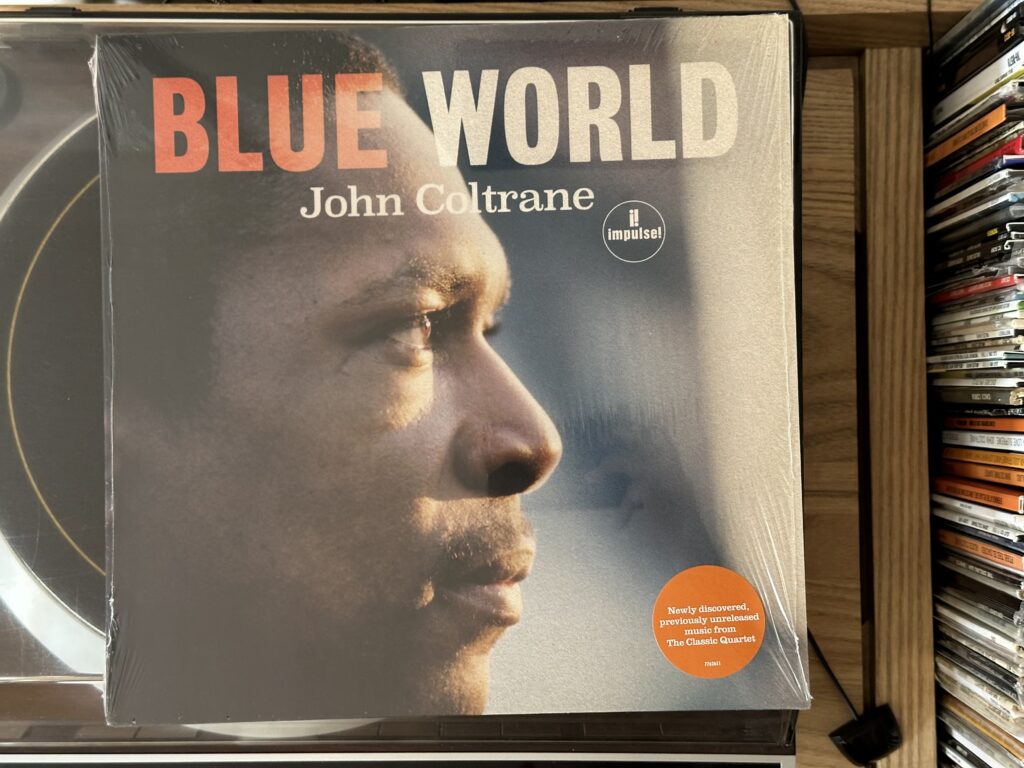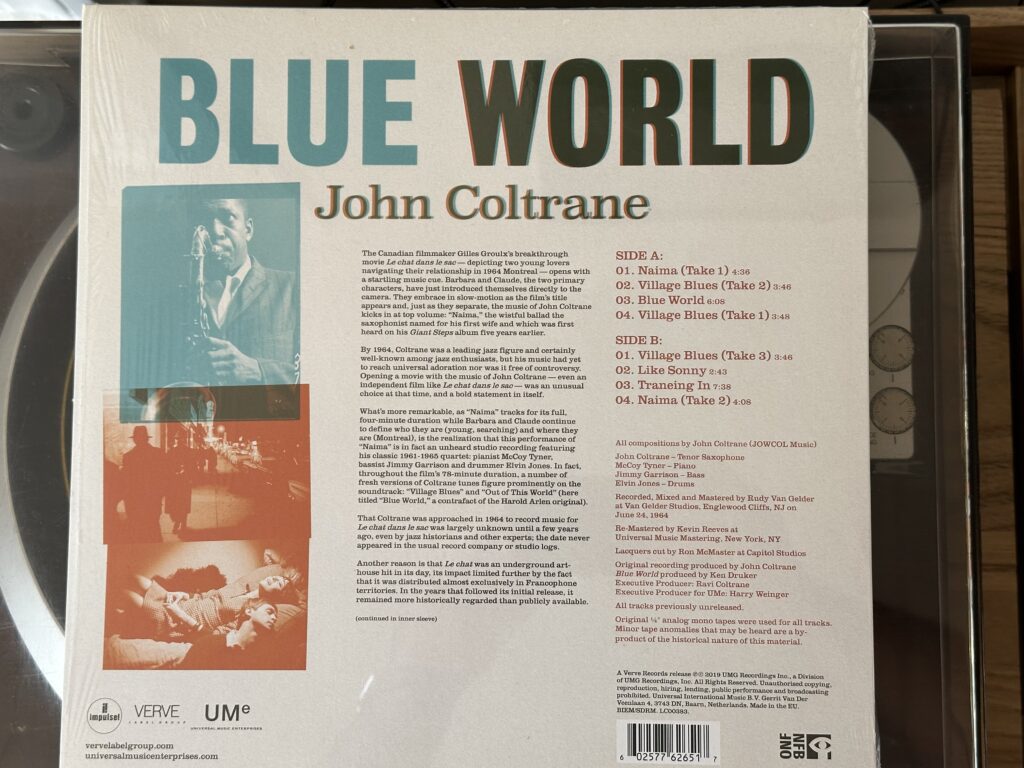
Album of the Week, March 2, 2024
Picture this: you are Michelangelo, on your way from carving David in Florence to respond to the Pope’s invitation to put up a fresco in the ceiling of the Sistine Chapel. But along the way, someone asks you to paint some scenery for a new theatrical production.
That’s not that different from what appears to have happened with Blue World, a “lost” Coltrane album which resurfaced in 2019, which consists of soundtrack recordings for the Gilles Groux-directed film Le chat dans le sac (literally, “The Cat in the Bag”)., and which was recorded on June 24, 1964, squarely between Crescent (April 27/June 1) and A Love Supreme (December 9). It’s tempting to view the album as a throwaway, especially since it consists of new versions of earlier works like “Naima,” “Traneing In,” “Village Blues” and “Like Sonny,” alongside the title track, the only new composition on the album. But it’s a recording of the John Coltrane Quartet, at the height of their powers, and so it still commands our interest.
Under any circumstances, it’s rewarding to hear Coltrane play his own ballads, and “Naima (Take 1), ” which leads off the album, is no exception. The ballad is played more or less straight in the arrangement that it debuted on Giant Steps, but there are some important differences. First, with McCoy Tyner on the keys, the piano accompaniment is much more free, filling in more of the texture under Trane’s melody. Where the original version pivoted cleanly between the keys of the tune, Tyner seems to play a kaleidoscope of chords that align along the path of the changes. He takes the solo as well, varying the rhythm, breaking into running eighth patterns and even briefly echoing “String of Pearls” at one point. Garrison and Jones keep the suspension of the accompaniment going, but at the point where Trane re-enters they collectively lock into a hemiola, a triple rhythm under Trane’s duple. It’s the same tune, they seem to say, but bigger things are afoot.
Trane’s “Village Blues,” of which three takes from the recording session appear on the album beginning with Take 2, first appeared on Coltrane Jazz, the follow-up to Giant Steps. It’s a blues in mixolydian mode, and Tyner explores and broadens the chord progression as Trane takes the solo. No sheets of sound here—the solo is melodic even as it reaches up to explore the outer stratosphere. Tyner takes a straightforward solo reading of the 12 bar melody to close out the short track.
“Blue World” is the new track on the album and it more than any other reveals the session’s place in Trane’s chronology. Jimmy Garrison opens with a bass solo that sketches out the barest hint of the mode, playing an octave leap down to a minor seventh. As important as the tonality is, the more significant thing that Garrison’s opening brings is a strong rhythmic drive, a pulse that grounds the explorations that follow. The formula of bass-led groove at the core of the composition would return on Trane’s next recording. Tyner joins after a few bars, completing the modal chord voicing, and then Trane enters playing a brief melody that feels like it was cut from an improvisation on “Lonnie’s Lament.” His solo begins melodically, and starts to climb for the stars, but instead of soloing entirely in the upper octave, he starts to explore the entire space of the music, diving down to the low octave before exploring on the same three-note grouping pattern he used at the end of “Autumn Serenade” (on John Coltrane and Johnny Hartman). When he returns to the melody, it’s as a signpost rather than closure; he continues to explore, digging into a chromatic exploration of time as Tyner provides a locked-in groove with block chords. Here Jones continually re-invigorates the music with a tumbling pattern on the drums that keeps things forward, until he bursts out as Trane reaches the coda. The whole thing is very much of a piece with the Crescent improvisations and gives more than a foretaste of what was to come next from the band.
“Village Blues (Take 1)” closes the first side. The quartet’s first approach at the tune features a little more improvisation around the statement of the melody and a much stronger voice from Elvin Jones, whose muscular statement of the rhythm emphasizes the syncopation in the tune and seems to egg Trane on into a more dramatic solo. Garrison has a more prominent part under Tyner’s solo verse on this version, leaning into the suspension. The same group dynamic seems to continue on “Village Blues (Take 3),” which opens side two. Jones here provides an even louder voice on the off beats, egging Trane on even as the saxophonist clings to a more melodic approach to his solo.
“Like Sonny” also hails from Coltrane Jazz, and the brief reading here is primarily notable for the full band exploration. Again Tyner provides fuller color, and takes the first solo with a primarily right-hand exploration of the tune. Trane joins in with what is almost a counter-melody played in the upper tenor octave, moving slightly away from the four-square rhythm under the quintuplet flourishes of the melody into something more waltz-like.
“Traneing In” is the oldest tune on the album. Originally recorded in 1957 for the album John Coltrane with the Red Garland Trio (which was later reissued in 1961 as Traneing In), that version began as a straight-ahead post-bop trio blues, with Trane not even appearing until a quarter of the way through the track. The version on Blue World opens with two Jimmy Garrison solo verses, offering a chance to hear Garrison’s rhythm, melodic imagination, and sense of drama (the chords at the end of each solo verse are especially juicy). After seeming to hover in the relative minor, when Tyner and Jones join the key coalesces back to the starting key of B♭ major. The trio takes a verse and only then does Trane join in. In contrast to his earliest solos on the tune, he stretches out the tonality, reaching down into other modes and pivoting into a different rhythmic structure before stretching into some overblowing and finally bringing the tune to a stop, having completely revolutionized it over the course of about two minutes and 40 seconds.
The final track, “Naima (Take 2),” starts very similarly to “Take 1.” The biggest difference is Elvin Jones, who is much more prominent in this take than the prior one, and who brings forward the triplet feel that characterized the back half of “Take 1.” Trane signs off his statement of the melody with a downward arpeggio down to the third, and Tyner picks it up. In both takes, Tyner’s solo feels almost double time, and this continues when Trane re-enters, with Jones really bashing the triplets throughout. When Trane transitions out of the bridge into the last recap of the melody, the feeling reverts to that more oceanic ballad tempo, but Jones gets the last word with a final crash and roll as if crashing that slow wave onto the shore.
Blue World is a fascinating document—having almost been lost to history, it reveals an important connection point between Trane’s earlier compositions and what was about to come. It also shows a quartet at the height of their telepathic connection, with their improvisations coming together to create something much bigger than the sum of its parts. The group’s telepathy would stand them in good stead on their next album; we’ll hear that next time.
You can listen to this week’s album here:

